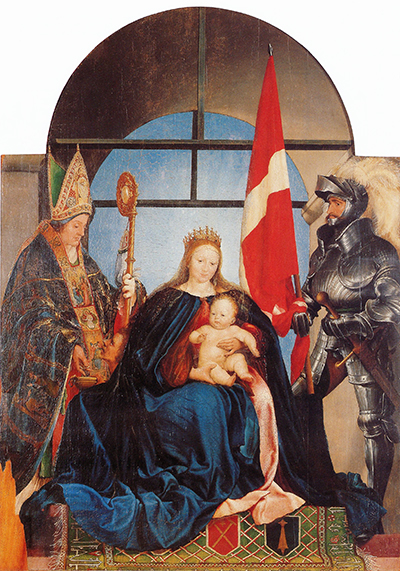Hans Holbein the Younger painted the Solothurn Madonna in 1522 as part of an ambitious project. Speculation is that the purpose of the painting was devotional as was customary during that period. The town secretary of Basel, Johannes Gerster, is said to have commissioned the piece.
Evidence of this is the family coat of arms that is included on the rug under the Virgin Mary's feet. The coat is made up of two shields - a red one with two crossed swords and a black one with a gold tassel. Solothurn Madonna is Hans Holbein's second largest surviving Madonna, trailing after the Darmstadt Madonna.
This piece by Holbein features the Virgin Mary seated, holding an infant baby Jesus. Two saints flank her. Historians have identified the saint on the right as St. Martin who is pictured offering alms to a beggar. The beggar is subtly hidden by the Virgin's robes, and he appears to peer from the garments. On the right is a soldier who has always been identified as St Ursus. He is in full gear with a sword swinging from his side and a red and white flag perched on his right arm. The knight was martyred in the Theban legion and venerated at the St. Martin Church in Basel. Historians believe that the painting was commissioned for this church.
Holbein chose the sacra conversazione form for this painting, which was a favourite in Upper Italy among prolific artists such as Giorgione and Bellini. In this form of the Madonna, the Virgin is the central figure, usually standing or sitting. Holbein shows extreme attention to detail in the Solothurn Madonna from the folds in the Bishop's Episcopal garb to the patterns on the rug. Holbein was known for portraits, and that prowess shines in this painting. He displays the features of the Virgin Mary, knight and bishop prominently. It is one of the few pieces in Holbein's collections that weren’t a portrait. The painting is considered a big contribution to the northern Renaissance style.
The Solothurn Madonna was lost for a while and showed up in a chapel in the Allerheiligenkapelle in 1864 in a deplorable condition. Restorer Andreas Eigner attempted to repair the damage, but it was not good enough. Another restoration in 1971 left the piece resembling the original closely. The painting was named after the town of Solothurn and has been its property since 1879.




